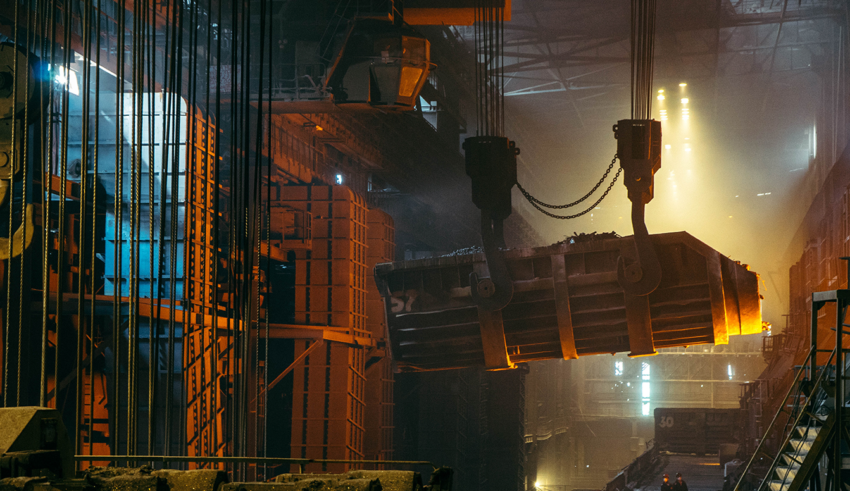PRESS RELEASES | 09/09/2021
Clear plan of action needed to cut industrial emissions, improve competitiveness and create jobs

Following the Government’s recent strategies on industrial decarbonisation and hydrogen, today the Aldersgate Group launches two major publications from Frontier Economics and University College London (UCL) calling for a more detailed policy framework to drive low carbon investment in heavy industry.
Based on significant engagement and case studies from several industrial sectors, these papers present tangible solutions to accelerate the decarbonisation of UK heavy industry in a way that will drive innovation, increase competitiveness, and create jobs across the country. [1]
Heavy industrial sectors like steel, cement, glass, and ceramics are essential to the UK’s economic prosperity, contributing £170bn to the UK economy and directly employing nearly 3 million people across the country [3]. As the UK transitions to a net zero economy, heavy industrial sectors will be fundamental to providing the building blocks for low carbon infrastructure, goods and services. They also have a unique opportunity to develop new competitive advantages and expand into new markets during the net zero transition.
Despite some welcome commitments in the Government’s Industrial Decarbonisation Strategy and Hydrogen Strategy, a more comprehensive and ambitious plan of action is urgently needed to deliver cuts from industrial emissions at the pace and scale demanded by the UK’s net zero target.
Backed by extensive engagement with industry representatives from manufacturing sectors such as steel, cement, glass, ceramics and chemicals, today’s publications put forward specific recommendations to scale up innovation, roll out supporting infrastructure and accelerate low carbon investment in industrial clusters and dispersed sites (Frontier Economics). They also feature proposals to tackle the investment and competitiveness barrier created by high industrial electricity prices, which is slowing down efforts to electrify and decarbonise parts of industry (UCL).
Nick Molho, Executive Director of the Aldersgate Group, said: “There is strong appetite across heavy industrial sectors to accelerate emission cuts and seize the potential opportunities created by the net zero transition in terms of innovation, new investment and job creation at industrial sites across the country. The Government now has a key role to play in supporting industry, by taking firm decisions on infrastructure funding and policy support and by tackling head on the investment barrier stemming from high industrial electricity prices.”
Accelerating the decarbonisation of industrial clusters and dispersed sites (Frontier Economics)
Industrial clusters and dispersed sites (those located more than 25km from the 6 major industrial clusters) contributed an estimated 37.6 MtCO2e and 33.6 MtCO2e of emissions respectively in 2018. [4] Despite differences in their net zero journeys and technological solutions, industries predominantly located in clusters (steel, chemicals) and those mainly located in dispersed sites (cement, glass, ceramics) will require similar policy solutions to decarbonise. Key recommendations in this report include:
1. Provide certainty to industry on the future availability of low carbon hydrogen, biomass, and carbon capture usage and storage (CCUS), by using contracts for differences (CfDs) and government matchmaking. Industrial producers need confidence that low carbon hydrogen and CCUS infrastructure will be available to support innovation and investment in low carbon technologies. To build on the commitments of its Hydrogen Strategy, the Government should establish a certification for low carbon hydrogen, explore CfDs for key alternative fuels and CCUS, legislate for low carbon hydrogen and CCUS targets, and act as a “matchmaker” between suppliers and industrial producers.
2. Work closely with Local Enterprise Partnerships (LEPs), local authorities (LAs) and devolved governments to design local infrastructure plans to help connect dispersed industries to the infrastructure being deployed in clusters. LEPs and LAs can play a key role in ensuring that dispersed industrial sites such as cement plants have access to the essential low carbon infrastructure located in industrial clusters.
3. Provide targeted UK ETS free allowances or support through Carbon Border Adjustment Mechanisms (CBAMs) to prevent unintended impacts during the transition to low carbon business models. In cases where the requisite policy, infrastructure, and technology support is not in place to allow specific industries to decarbonise and respond to carbon price signals, industries should receive interim support in the form of free allowances or CBAMs to avoid a competitive disadvantage and the risk of carbon leakage.
4. Drive greater resource efficiency in industry through changes to regulation and increased accessibility of funding. Changes to building and waste regulations and introducing targets for recyclable material could be of significant benefit to sectors such as glass (which can use recycled glass in production) and steel (around 90% of end-of-life steel could be collected and recycled in electric arc furnaces). Access to innovation funding, such as through the Industrial Energy Transformation Fund, should be made easier by simplifying timelines and allowing businesses to apply for funding on a rolling basis.
5. Introduce demand-side policies to grow the markets for low carbon and resource efficient industrial products. This could be done by using product standards (similar to the Buy Clean California Act for construction materials), procurement policies (such as the CO2 Performance Ladder used in the Netherlands), and information campaigns.
Matthew Bell, Director and Joint Head of Public Policy at Frontier Economics, said: “The UK has an opportunity to develop competitive, low carbon industries to match growing global demand for low carbon industrial products. Meeting this demand is likely to help a very broad range of industrial sectors. Our report highlights the most important and urgent actions that the Government must take to help UK industry take the lead in winning new contracts, whilst also meeting our climate commitments.
These actions include improving the predictability of the future supplies of low carbon fuels, enhancing the links between Westminster and parts of local government (including Local Authorities and Local Enterprise Partnerships), and ensuring the UK’s trade policy supports the competitiveness of UK businesses as they move to net zero – such as through the possible introduction of carbon border adjustments and demand led measures such as product standards.”
Delivering competitive industrial electricity prices in an era of transition (UCL)
The UK has significantly higher industrial electricity prices than European competitors. With electrification key to industrial decarbonisation, delivering low cost and low carbon electricity is essential. Seizing the opportunity provided by the rapidly declining policy costs of renewables must be a priority. Key recommendations from this briefing include:
1. Maintain an efficient framework to accelerate investment in the cheapest forms of mature renewable energy such as onshore wind, accompanied by a predictable, rising carbon price to reduce investor risk. Offshore wind should be further supported with investment in surrounding supply chains and infrastructures such as ports.
2. Establish an integrated approach to network development, funding, and pricing. Independent Future System Operator Objective(s) should include more coordinated oversight of future generation and network developments, to minimise costs and facilitate the power sector’s transition to zero emissions.
3. Support continued growth of interconnection (through Ofgem’s cap-and-floor revenues system) and offshore grid development and reduce friction in electricity trade. Each 1GW of interconnection capacity can reduce UK wholesale electricity prices by 1-2%, [5] by making low cost, low carbon imports available and increasing variable supply and demand. The government should seek to restore UK participation in the day-ahead electricity markets with neighbouring EU countries, the absence of which is estimated to result in £45 million in lost trade in 2021. [6]
4. Establish a market for long-term, zero carbon and tradable electricity contracts, grounded in the declining cost of unsubsidised renewable electricity sources. These contracts would mitigate the indirect costs of carbon prices, and the volatility of fossil fuel prices.
5. Investigate options for moving some policy costs from electricity prices to gas prices over time, with interim competitiveness support for major gas users unable to electrify or transition to low carbon fuels in the short term. This will incentivise electrification and more evenly distribute the costs of the low carbon transition, while ensuring industry has the appropriate support to remain competitive.
6. Improve scrutiny and transparency of reported electricity price data. In order to effectively assess the degree to which electricity prices faced by UK industrial consumers are changing, both over time and relative to international competitors, reliable data is crucial. As part of Quality Assurance we recommend a review of how this data is requested, collected, and reported by BEIS.
Michael Grubb, Professor of Energy and Climate Change at UCL Institute for Sustainable Resources, said: “The UK electricity system has already undergone part of its low carbon transition. Thanks in large part to carbon pricing, coal is no longer significant – and that in itself reduces the impact of carbon costs on UK electricity prices. But industry is still carrying the legacy cost of building up renewables, which are part of the larger energy transition. Those costs could be spread more evenly, and in particular, reforms are needed to ensure that industry can benefit both from access to the now-cheap renewables, and from smoother participation in the capacity market.”
Paul Drummond, Senior Research Fellow at UCL Institute for Sustainable Resources, said: “Historic investment in the deployment of renewable energy technology, and the substantial reductions in cost it produced, now presents the UK with a clear opportunity to both reduce the high electricity prices faced by energy-intensive industries relative to many of continental neighbours, and emissions reduction through increasing electrification. The government must make sure a clear, long-term policy architecture is in place to encourage investment in increasingly subsidy-free renewables and grid interconnection, and effective and efficient markets in electricity trade and system balancing.”
Laura Cohen, Chief Executive of the British Ceramic Confederation, said: “Almost all of our members’ 150 sites are located off-cluster. To switch from firing with gas we need to move to hydrogen, bioenergy, or electricity. We need policy interventions now for off-cluster manufacturers to remain competitive over this extended period until options are widely available, particularly as most of our members are paying an eye-watering £130/MWh which makes electrification uneconomic. Given the scale of the challenge we need much more government funding and supportive policies to develop and implement decarbonisation technologies for these off-cluster sites.”
Martin Casey, Director of Public Affairs Europe at CEMEX, said: “CEMEX very much welcomes these two reports: Individually, and when considered together, they provide deep insight into the real challenges faced by UK industry and provide well thought-out suggestions for actions and policies that the Government should take onboard. The competitive, sustainable and climate neutral future of essential material production in the UK depends on it”.
Sam French, Business Development Director at Johnson Matthey, said: “Decarbonising and modernising the UK’s heavy industrial sectors is an urgent necessity on both climate and economic grounds. These two reports provide a clear plan of action to drive innovation, cut the cost of new technologies, improve the competitiveness of industry and drive job creation. Industry needs a clear, net zero aligned roadmap to deploy hydrogen and CCUS infrastructure, alongside predictable revenue mechanisms and carbon pricing trajectories to unlock private investment in new technologies, business models and skills.”
Edward Heath-Whyte, Head of Environment and Sustainability at Liberty Steel, said: “As we approach COP26 it is important to ensure the low carbon transition for energy intensive industries is supported by appropriate policy measures. Liberty Steel UK is committed to supplying GREENSTEEL from its Rotherham Electric Arc Furnaces as part of the UK’s transition to becoming a low carbon economy. It is important that government takes steps to help drive this innovation from industry, in order to accelerate the net zero transition. As the Rotherham steelmaking plant is a ‘dispersed site’, we support the recommendations made in this report to help us and other sites like Rotherham accelerate the pace and cost-efficiency of reaching net zero.”
Shane Hughes, Carbon Consulting Lead at Ramboll, said: “We welcome Aldersgate Group’s well informed policy recommendations. Britain kick started the Industrial Revolution but now heavy industry urgently needs ambitious policies to support the UK to again lead in the Net Zero Revolution. Get this right and heavy industry can both be climate positive and attract massive inward investment.”
Brian Holliday, Managing Director, Siemens Digital Industries, GB&I said “For the UK to achieve carbon net zero by 2050 it’s vital that UK manufacturing decarbonises. Whilst UK Government’s policy framework is advancing, industry needs greater forward certainty to allow leaders across the spectrum to plan effectively. This report highlights the challenges facing manufacturers with complex operations and I trust it will catalyse focus to address their needs. Industry has much work to do and needs greater insights to the art of the possible and more accessible technology solutions from multiple vendors.”
Dr Martyn Kenny, Sustainability Director at Tarmac, said: “Achieving the decarbonisation of UK heavy industry will require close collaboration between government and the UK cement and concrete sector. A comprehensive and ambitious plan is now needed to develop the policy environment, technologies and supporting infrastructure essential to decarbonise both industrial clusters and dispersed sites.
Tarmac is committed to this transition and has defined a clear pathway to not only achieve net zero by 2050, but even to go beyond net zero and remove more carbon than we emit. It is now critical that government delivers the policies needed to provide clarity and certainty, in order to facilitate a just transition that supports investment, competitiveness and jobs.”


